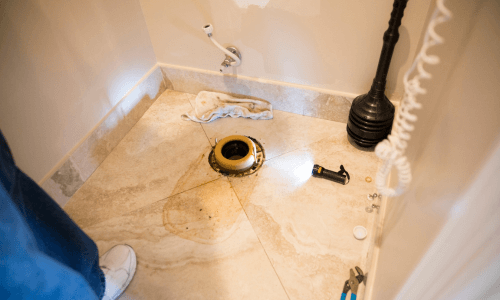
7 Reasons Why Your Toilet Is Leaking at the Base
A leaking toilet at the base is a common plumbing issue that can lead to water damage, mold growth, and increased utility bills if left unaddressed. As experienced professionals at Local Plumber with years of experience in diagnosing and repairing toilet leaks, we understand the frustration and inconvenience this problem can cause for homeowners. In this comprehensive guide, we will explain seven common reasons why your toilet may be leaking at the base and provide expert insights on how to resolve each issue effectively.Damaged Wax Ring:
The wax ring seals the connection between the toilet and the flange, preventing water from leaking out at the base. Over time, the wax ring can become compressed, cracked, or damaged, leading to leaks. Signs of a damaged wax ring include water pooling around the base of the toilet, foul odors, and loose or wobbly toilet.To resolve this issue, the damaged wax ring needs to be replaced. This involves removing the toilet, scraping off the old wax ring, installing a new wax ring, and reseating the toilet properly. It’s essential to ensure that the toilet is securely fastened to the floor to prevent future leaks.
Loose Toilet Bolts:
The toilet bolts, also known as closet bolts or flange bolts, secure the toilet to the floor and the flange. If these bolts are loose or improperly tightened, water can seep out at the base of the toilet. Loose toilet bolts may also cause the toilet to wobble or shift, exacerbating the problem.To address this issue, the toilet bolts need to be tightened or replaced if they are damaged or corroded. Carefully remove the toilet caps, located at the base of the toilet, and use a wrench to tighten the bolts. Ensure that the toilet is level and securely anchored to the floor after tightening the bolts.
Cracked Toilet Base:
A cracked toilet base can also cause leaks at the bottom of the toilet. Cracks in the porcelain or ceramic material of the toilet can develop due to age, impact damage, or stress from uneven weight distribution. Water may seep through these cracks, leading to leaks and water damage to the surrounding area.Unfortunately, repairing a cracked toilet base is often not feasible, and the best solution is to replace the toilet entirely. A professional plumber can assess the extent of the damage and recommend a suitable replacement toilet that meets your needs and budget.
Damaged Flange:
The toilet flange is a circular piece of plastic or metal that connects the toilet to the drainpipe and floor. If the flange is damaged or deteriorated, it may not provide a secure seal, resulting in leaks at the base of the toilet. Common causes of flange damage include corrosion, improper installation, and age-related wear and tear.Repairing or replacing a damaged flange requires specialized tools and expertise. A professional plumber can inspect the flange, repair minor damage if possible, or recommend a replacement flange if necessary. Proper installation of the flange is crucial to ensure a watertight seal and prevent future leaks.
Faulty Supply Line:
The supply line delivers water from the wall-mounted shut-off valve to the toilet tank. If the supply line is damaged, loose, or improperly connected, water may leak out at the base of the toilet. Common signs of a faulty supply line include water pooling around the toilet base, dampness on the floor, and reduced water flow to the toilet tank.To address this issue, inspect the supply line for any visible damage, such as cracks, kinks, or loose connections. Tighten any loose fittings or replace the supply line if it is damaged or corroded. It’s essential to turn off the water supply to the toilet before performing any repairs or replacements.
Condensation:
In humid environments or during temperature fluctuations, condensation may form on the exterior of the toilet tank and bowl. While condensation itself is not a leak, it can create the appearance of a leak by causing water to pool around the base of the toilet. This phenomenon is more common in bathrooms with poor ventilation or high humidity levels.To reduce condensation buildup, improve ventilation in the bathroom by using exhaust fans or opening windows during showers. Additionally, consider installing insulation on the toilet tank to prevent temperature differences between the tank and the surrounding air. Wiping down the exterior of the toilet regularly can also help prevent water from accumulating around the base.
Cracked or Damaged Grout:
The grout or caulking around the base of the toilet serves as a sealant, preventing water from seeping between the toilet and the floor. If the grout is cracked, deteriorated, or improperly applied, water may leak out at the base of the toilet. This can occur due to age, shifting of the toilet, or improper installation.To address this issue, remove the old grout or caulking from around the base of the toilet using a scraper or putty knife. Clean the area thoroughly to remove any debris or residue. Apply a new bead of waterproof caulk or grout around the base of the toilet, ensuring a tight seal between the toilet and the floor.
A leaking toilet at the base is a common plumbing problem that requires prompt attention to prevent water damage and other issues. By identifying the underlying cause of the leak and taking appropriate corrective measures, homeowners can effectively resolve the problem and restore the integrity of their plumbing system. Whether it’s replacing a damaged wax ring, tightening loose toilet bolts, or addressing condensation buildup, consulting with a professional plumber is essential for accurate diagnosis and reliable repairs. With proper maintenance and timely intervention, homeowners can ensure that their toilets remain leak-free and functional for years to come.
24/7 Toilet Repair & Replacement In Florida
Get in touch with us today for a quote and let us handle all your plumbing needs. Email us at services@local-plumber.com or call us at 813-776-7667 (POOP).Also Read: Common Toilet Problems and How to Fix Them





Leave a comment